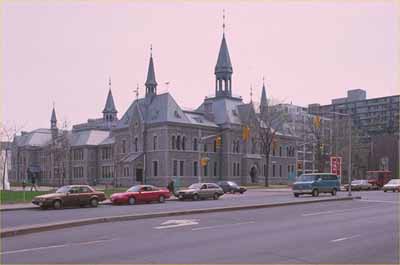Former Ottawa Teachers' College National Historic Site of Canada
Ottawa, Ontario

General view
(© Parks Canada Agency/ Agence Parcs Canada, 1993.)
Address :
195 Elgin Street, Ottawa, Ontario
Recognition Statute:
Historic Sites and Monuments Act (R.S.C., 1985, c. H-4)
Designation Date:
1974-11-15
Dates:
-
1874 to 1875
(Construction)
-
1974 to 1974
(Significant)
-
1919 to 1919
(Significant)
-
1980 to 1990
(Restoration)
-
1879 to 1879
(Addition)
-
1891 to 1892
(Other addition)
Event, Person, Organization:
-
W.R. Strickland
(Architect)
Other Name(s):
-
Former Ottawa Teachers' College
(Designation Name)
-
Ottawa City Hall
(Other Name)
Research Report Number:
1974-P
Plaque(s)
Existing plaque: Inside Regional Municipality of Ottawa-Carleton Headquarters 195 Elgin Street, Ottawa, Ontario
The Ottawa Teachers' College or Normal School, designed by the architect W. R. Strickland and built in 1875 by J. Forin, was the second institution of its type to be established in Ontario. The rear wing was added in 1879 to house a model school. The College continued to train teachers for Ontario until 1974. While the general massing of forms, with central and side pavilions, follows the 19th Century Academic tradition, the use of disparate architectural details including the pointed gothic windows, semi-circular italianate windows, romanesque columns and second empire roof, reflects a spirit of eclecticism.
Description of Historic Place
The Former Ottawa Teacher’s College National Historic Site of Canada is located on Elgin Street in downtown Ottawa. A fine example of late-19th century eclectic design, the building’s two-and-a-half-storey front block is a balanced composition exhibiting an eclectic interpretation of the Gothic Revival Style. The roof, in the Second Empire style, with a central spired belfry, features a gable and a lively series of turrets. The building is now part of the Ottawa City Hall Complex. Official recognition refers to the former school building on its original lot.
Heritage Value
The Former Ottawa Teacher’s College was designated a national historic site of Canada in 1974 because it is a nationally significant example of the Gothic Revival Style in Canada whose use of disparate architectural details reflects a spirit of eclecticism.
The Ottawa Teacher’s College or Normal School, designed by the architect W.R. Strickland and built in 1874-1875 by J. Forin under supervising architect James Mather, was the second institution of its type to be established in Ontario. The College continued to train teachers for Ontario until 1974. Purchased by the regional government, an office complex was constructed to the rear. After municipal amalgamation, the building became part of Ottawa City Hall.
The rectangular massing with central pavilion of the main block follows an accepted format for 19th century academic institutions, while the use of disparate architectural details including a mix of pointed Gothic-style, semi-circular and flat-headed windows, Romanesque columns, and Second Empire-style roof, reflects a spirit of eclecticism.
Source: Historic Sites and Monuments Board of Canada, Minutes, November 1974.
Character-Defining Elements
The key elements that contribute to the heritage character of this site include:
the prominent location in central Ottawa on Elgin Street; the principal elevation’s two-and-a-half-storey rectangular massing with its lively roofline, and two storey extension; the stone construction with window and corner quoining; the design in the Gothic Revival Style with elements from the Romanesque, Second Empire and Italianate; the lively and varied roofline with gables and turrets; the balanced placement of the doors and the windows; the projecting frontispiece and main entrance with decorative stonework, including Romanesque columns and round-arched windows set within Gothic Revival style surrounds; the pronounced stringcourse between ground and second storey; the surviving original interior features and finishes; evidence of its original interior plan and spatial organisation.